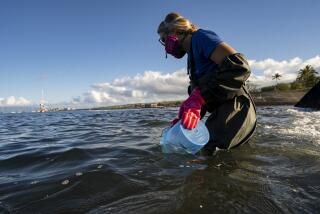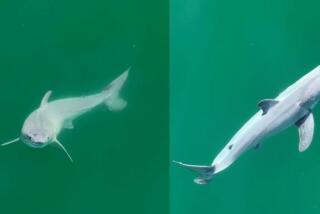Undersea light show: The secret neon world of biofluorescent fish
Scientists have discovered more than 180 species of biofluorescent fish that glow in neon shades of blue, red, orange and green -- most of them hiding out in tropical coral reefs.
Some of the fish glow just around their eyes. Others have intricate fluorescent patterns on their bellies or backs. And some of the fish glow all the way through their bodies. If you slice a false moray eel like a salami and shine a blue light on it, the entire cross-section would illuminate.
And it turns out that reef fish that are the most mottled and brown and difficult to see are the ones that tend to fluoresce the most.
“There is a whole light show going on down there,” said John Sparks, a curator of ichthyology at the American Museum of Natural History and the author of a new paper published Wednesday in PLOS ONE describing a wide variety of biofluorescent fish. “There have been studies on corals that are biofluorescent, but for fish, virtually nothing was known.”
To be clear, biofluorescence is not the same as bioluminescence. Animals that bioluminesce, such as fireflies and 80% to 90% of deep sea animals, make their own light by mixing the chemical luciferin and the enzyme luciferase together. (Sometimes they host bacteria that do the mixing for them). The reaction between the two agents causes the emission of a photon of light.
Biofluorescence is a whole different process. Biofluorescent animals make a protein that absorbs light, transforms it and then re-emits it as a different color, Sparks said. Biofluorescent animals can only glow when there is ambient light around. Turn out the lights, and the animal no longer glows.
The human eye can readily detect the glow made by deep sea bioluminescent animals, but seeing the glow from a biofluorescent animal can be more difficult. That may explain why the phenomenon had not been widely observed before.
While searching for biofluorescent fish on the coral reefs of the Bahamas and the Solomon Islands, Sparks and his co-author, David Gruber, used specially designed blue lights to stimulate the biofluorescence. They also had light filters over their masks and cameras that made the biofluorescence more obvious.
It turns out that some fish naturally filter light from the water in a similar way. Sparks said that many of the fish they studied have yellow filters built into their eyes. “They act to cut out all the ambient blue light so they can just see the fluorescent patterns,” he said.
Sparks and Gruber hypothesize that the fluorescent patterns on the fish could help them with communication, or help them blend into the fluorescent corals in their environment.
Steve Haddock, a scientist at the Monterey Bay Aquarium Research Institute who was not involved in the study, said that while the survey was interesting, it was not necessarily as novel as the researchers were making it out to be.
“If you look at humans under a black light, our skin glows, our eyes glow, our teeth glow -- there are a lot of natural compounds out there that can fluoresce,” he said. “In the case of the paper it is hard to tell what are actual fluorescent structures and what is just a side effect of the fishes’ skin and scales. It opens up an area where we need to do more research and ask more questions.”
Sparks agrees that there is much more research to do. There are other groups of bony fish that he and his team have not yet scanned for biofluorescence, and he said there are also more sharks to look at. Additionally, his team wants to determine what proteins are causing the fish to glow, as well as see how this previously hidden fluorescence evolved among species.
In the meantime, ocean lovers may want to try night dives with blue lights. Sparks said there are lots of animals that fluoresce right off the coast of Southern California.
If you love to learn about the secret, glowing world underwater, then follow me on Twitter for more stories like this.
ALSO:
Meet the animals that fascinated scientists in 2013
Ethereal, 8-foot-long ‘sea serpent’ caught on video
Glow-in-the-dark pigs are part of radiant green menagerie







